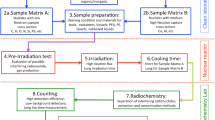Abstract
One-hundred-two years ago, on 21 April 1910, the Austrian chemist Carl Auer von Welsbach published a short comment on a fundamental discovery he had made in the field of nuclear sciences. He reported that “jonium” (230Th) was able to induce radioactivity in other materials if stored in contact with the ionium sample. He was well aware that this observation was “not quite in agreement with current theories”, because, as a basic principle, a radioactive substance cannot activate an inactive substance. Since he could not remove any superficial contamination, he concluded that the previously inactive materials had become radioactive themselves. Auer von Welsbach predicted that this observation “might be of importance for the mysterious field of radioactivity research”. In fact, we believe that in this experiment he incidentally discovered neutron activation and the production of artificial radionuclides (24 years before I. Curie and F. Joliot) or even induced nuclear fission. The neutron source in his experiments is yet unknown and shall be identified in this project. The neutrons could have been produced from nuclear reactions with impurities of beryllium in the sample. Auer von Welsbach may even have observed nuclear fission 29 years before O. Hahn, F. Straßmann, L. Meitner and O. R. Frisch. In any case, he may have noticed the effects of neutron radiation—22 years before its discovery by J. Chadwick. The main aim of this interdisciplinary project (of which preliminary results are presented herein) is to repeat the 1910-experiment and to identify the source of the neutrons. It will be equally important to investigate the historical reasons and circumstances why Auer’s report remained mostly uncommented in the scientific community. The hypothetical consequences are worth discussion: Auer’s publication could have started the “nuclear age” much earlier than it finally began, with all the consequences for mankind.





Similar content being viewed by others
References
Chadwick J (1932) Nature (London) 129:312
Chadwick J (1932) Proc R Soc Lond Ser A 136:692–708
Joliot F, Curie I (1934) Nature (London) 133:201–202
Hahn O, Straßmann F (1939) Naturwissenschaften 27:11–15
Meitner L, Frisch OR (1939) Nature (London) 143:239–240
Bothe W, Becker H (1930) Z Phys 66:289–306
Curie I (1931) Compt rend 193:1412–1414
Webster HC (1932) Proc R Soc Lond Ser A 136:428–453
Auer von Welsbach C (1885) Sitzungsberichte der Akademie der Wissenschaften 92:317–330
Steinhauser G, Giester G, Leopold N, Wagner C, Villa M (2009) Helv Chim Acta 92:2038–2051
Auer von Welsbach C (1907) Sitzungsberichte der mathematisch-naturwissenschaftlichen Klasse der kaiserlichen Akademie der Wissenschaften 116:1425–1469
Steinhauser G, Giester G, Wagner C, Leopold N, Sterba JH, Lendl B, Bichler M (2009) Helv Chim Acta 92:1371–1384
Auer von Welsbach C (1891) Glühkörper, DRP 39162
Poljanc K, Steinhauser G, Sterba JH, Buchtela K, Bichler M (2007) Sci Total Environ 374:36–42
Auer von Welsbach C (1898) Elektrische Glühlampe, CH16133
Auer von Welsbach C (1904) Manufacture of metallic alloys having pyrophoric action and their application to the purposes of ignition and illumination, GB190316853
Löffler G (2008) Nachr Chem 56:889–892
Haitinger L, Ulrich K (1908) Mitteilungen der Radium-Kommission der kaiserlichen Akademie der Wissenschaften. Sitzungsberichte 117:619–630
Auer von Welsbach C (1910) Sitzungsberichte der Akademie der Wissenschaften 119:1011–1054
Auer von Welsbach C (1910) Mitteilungen der Radium-Kommission der kaiserlichen Akademie der Wissenschaften. Chemie-Heft 10:1159–1202
Griggs K (1973) Science 181:842–843
Steinhauser G, Evers J, Jakob S, Klapötke TM, Oehlinger G (2008) Gold Bull 41:305–317
Steinhauser G, Musilek A (2009) Environ Res Lett 4:034006
Steinhauser G, Bichler M (2008) Appl Radiat Isot 66:1–8
Steinhauser G, Sterba JH, Bichler M (2007) Appl Radiat Isot 65:488–503
Adlassnig W, Steinhauser G, Peroutka M, Musilek A, Sterba JH, Lichtscheidl IK, Bichler M (2009) Appl Radiat Isot 67:2117–2122
Acknowledgments
We gratefully acknowledge financial support by the Austrian Academy of Sciences in the form of the Bader Award for the History of Sciences 2010 as well as the Theodor Körner Fonds in the form of the Theodor Körner Preis 2011, respectively. Further we are indebted to Ingrid Groß for her transcription of the original documents of interest as well as to Stefan Merz for his assistance in the course of the measurements.
Author information
Authors and Affiliations
Corresponding author
Rights and permissions
About this article
Cite this article
Steinhauser, G., Löffler, G. & Adunka, R. The possible discovery of neutron activation in 1910. J Radioanal Nucl Chem 296, 157–163 (2013). https://doi.org/10.1007/s10967-012-2065-7
Received:
Published:
Issue Date:
DOI: https://doi.org/10.1007/s10967-012-2065-7




